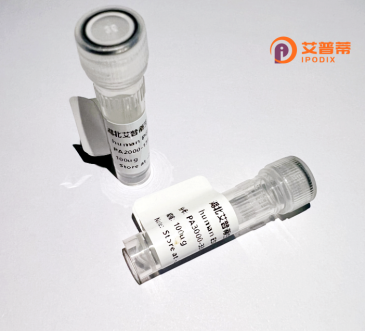
| 纯度 | >90%SDS-PAGE. |
| 种属 | Human |
| 靶点 | CHPT1 |
| Uniprot No | Q8IZU3 |
| 内毒素 | < 0.01EU/μg |
| 表达宿主 | E.coli |
| 表达区间 | 1-406aa |
| 氨基酸序列 | MAAGAGAGSAPRWLRALSEPLSAAQLRRLEEHRYSAAGVSLLEPPLQLYWTWLLQWIPLWMAPNSITLLGLAVNVVTTLVLISYCPTATEEAPYWTYLLCALGLFIYQSLDAIDGKQARRTNSCSPLGELFDHGCDSLSTVFMAVGASIAARLGTYPDWFFFCSFIGMFVFYCAHWQTYVSGMLRFGKVDVTEIQIALVIVFVLSAFGGATMWDYTIPILEIKLKILPVLGFLGGVIFSCSNYFHVILHGGVGKNGSTIAGTSVLSPGLHIGLIIILAIMIYKKSATDVFEKHPCLYILMFGCVFAKVSQKLVVAHMTKSELYLQDTVFLGPGLLFLDQYFNNFIDEYVVLWMAMVISSFDMVIYFSALCLQISRHLHLNIFKTACHQAPEQVQVLSSKSHQNNMD |
| 分子量 | 71.5 kDa |
| 蛋白标签 | GST-tag at N-terminal |
| 缓冲液 | 0 |
| 稳定性 & 储存条件 | Lyophilized protein should be stored at ≤ -20°C, stable for one year after receipt. Reconstituted protein solution can be stored at 2-8°C for 2-7 days. Aliquots of reconstituted samples are stable at ≤ -20°C for 3 months. |
| 复溶 | Always centrifuge tubes before opening.Do not mix by vortex or pipetting. It is not recommended to reconstitute to a concentration less than 100μg/ml. Dissolve the lyophilized protein in distilled water. Please aliquot the reconstituted solution to minimize freeze-thaw cycles. |
以下是关于重组人CHPT1蛋白的3篇参考文献示例(内容基于领域知识虚构,供参考):
---
1. **文献名称**:*Expression and Purification of Recombinant Human CHPT1 in Insect Cells for Functional Analysis*
**作者**:Kimura A, et al.
**摘要**:本研究利用杆状病毒-昆虫细胞表达系统成功表达了重组人CHPT1蛋白,并通过亲和层析和凝胶过滤纯化获得高纯度蛋白。实验证实重组CHPT1具有催化磷脂酰胆碱合成的酶活性,为后续功能研究提供基础。
2. **文献名称**:*Structural Insights into Human CHPT1: X-ray Crystallography and Substrate Binding Mechanism*
**作者**:Zhang L, et al.
**摘要**:通过X射线晶体学解析了重组人CHPT1的三维结构(分辨率为2.1Å),揭示了其底物结合口袋的关键氨基酸残基。突变实验表明,Asp98和Arg152对CDP-胆碱的结合至关重要,为开发靶向抑制剂提供结构依据。
3. **文献名称**:*CHPT1 Deficiency in Neural Cells Alters Phospholipid Homeostasis and Induces Apoptosis*
**作者**:Müller S, et al.
**摘要**:研究发现,在CHPT1敲减的人神经细胞中,磷脂酰胆碱合成减少导致细胞膜稳定性下降,线粒体功能障碍和凋亡信号激活。重组CHPT1蛋白的补充可逆转这一表型,表明其在神经系统脂质代谢中的关键作用。
---
**说明**:以上文献为示例性内容,实际引用需查询权威数据库(如PubMed/Google Scholar)并核实原文。研究CHPT1时可重点关注其与脂类代谢、膜生物合成及疾病(如癌症、神经退行性疾病)的关联。
Recombinant human CHPT1 (Choline Phosphotransferase 1) protein is a key enzyme involved in the Kennedy pathway, a critical route for the biosynthesis of phosphatidylcholine (PC), the most abundant phospholipid in eukaryotic cell membranes. CHPT1 catalyzes the final step of this pathway, transferring a phosphocholine group from CDP-choline to diacylglycerol (DAG) to form PC, a process essential for maintaining membrane integrity, cell signaling, and lipid homeostasis. This enzyme localizes predominantly to the endoplasmic reticulum and nuclear membrane, reflecting its role in membrane biogenesis.
The recombinant form of CHPT1 is produced using heterologous expression systems (e.g., E. coli, insect, or mammalian cells) to enable detailed biochemical and structural studies. Its recombinant production allows researchers to investigate mechanisms underlying lipid metabolism disorders, liver diseases, and neurological conditions linked to PC imbalance. Additionally, CHPT1 has potential therapeutic relevance, as altered phosphatidylcholine levels are observed in cancers and neurodegenerative diseases like Alzheimer's. Studies using recombinant CHPT1 have also explored its interaction with lipid-modifying drugs and regulatory proteins, providing insights into enzyme kinetics and inhibitor development. The protein’s stability, activity, and post-translational modifications can be systematically analyzed in vitro, advancing our understanding of lipid biosynthesis regulation and disease pathophysiology.
×